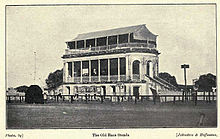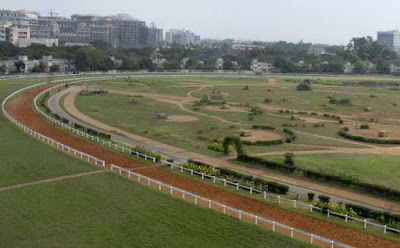 |
| www.offthepace.net |
 |
| Royal Calcutta Turf ClubPolka Cafe |
 |
| macsstuff.net |
 |
| twitter.com |
 |
| The English Blog |
Sir Charles Forbes, G Hall, A Campbell and P Haddow started in 1800 Bombay Turf Club in Byculla grounds that they acquired through the good offices of Dorabji Rustomji of Bombay. The marshy land was converted into a race course by the Club. In the early stages, the balcony of the clubhouse was the only place used as a private stand for the honorable Members. Soon the name was changed to the Western India Turf Club. It was in 1819 the first horse race was held in Pune with a 100-guinea cup donated by the British Resident and later Governor of Bombay, the Hon. Mr Mountstuart Elphinstone, as the trophy – one year after the end of the Last Anglo-Maratha War and the Peshwa's reign. In 1830 the Pune Race Course was built on the present site in the Cantonment near the Empress Garden.
The racing track in Mahalaxmi is oval shaped with 2,400 metres (7,900 ft) straight chute, spread over approximately 225 acres (0.91 km2; 0.352 sq mi) of open land in the prime area of Mumbai city. In 1935 HRH King George V, Emperor of India, granted permission to add the prefix “Royal” to the Club’s name.
Pune Race Course located in Pune Cantonment, western India was built in 1830 and it covers 118.5 acres (48.0 ha) of land under the control of the Indian army.
 |
| Mahalaxmi,race track. Mumbai. en.wikipedia.org |
 |
| The Bangalore Race Club. Tourmet |
These gentlemen approved to form a race club in the city. There were to be 30 club members. The Stewards could elect an unlimited number of stand members. The admission charges for both types of memberships was Rs 20. Men were required to pay while entry was free for women. The Bangalore Race Club was formed in 1951 and started to run the Mysore races also.
Hyderabad Turf Club - conducts racing in Hyderabad where racing is held on the Monsoon Track from July until the end of October and on the Winter Track from November until February. Hyderabad usually races on Sundays and Mondays.
 |
| Hyderabad Turf Club, india www.123rf.com |
 |
| Hyderabad Turf Club, india. view suggestions |
Royal Calcutta Turf Club, Kolkata - conducts racing in Kolkata, with a main winter season from November to April and a monsoon season which runs from July until mid October.
 |
| Calcutta Turf Club race course stands before 1905 en.wikipedia.org |
 |
| Royal Calcutta Turf club, Calcutta. wikimapia.org |
The Mysore Race Club - conducts regular season between mid-August and the end of October, as well as smaller summer and winter seasons. It is the most picturesque in the country on the foothills of the imposing Chamundi Hills.There are 250 members in the Mysore Race Club. It all began in 1891 in Mysore under the patronage of the Royal Family of Mysore and the ruler was Chamaraja Wadiyar. The new facility of the race course was built by Krishnaraja Wadiyar in 1906.The original location of the Race Course was near the present J.C.College.The present race course was established in 1920 by H H Sri Nalvadi Krishnaraja Wadiyar, the then ruler of Mysore. The race covered a152-acre prime land. The races were affiliated to the Royal Calcutta Turf Club.
 |
| The Mysore Race Club YouTube |
 |
| Delhi Race Club. Club Times: India's First Club Aggre |
 |
| www.drcraces.com |
 |
| Madras Race Club The Hindu |
 |
| First ever race meet in India. This was in 1780.madrasmusings.com |
Chennai city (Old Madras) has one of the oldest race course in India, and has the record of hosting horse races for around 235 years with a brief hiatus in between. in August, 1974 the Tamil Nadu government banned horse racing on moral grounds, however the High court stayed it and in 1996 the Supreme court struck down the state government's ban on horse racing. races resumed in 1978. Earliest racing goes as far back as 1777, however there were some breaks in racing in the late 1700s on account of war between the British and Hyder Ali who came almost close to Madras, and then again in the 1870s. The Madras Race Club was established in 1837 and for this purpose parts of villages were allocated. The club functioned till 1875, when the Prince of Wales Edward VII visited Madras. Horse racing was revived in 1887, though it was a tough period and the club has been organizing the races since then. Again the racing was interrupted by the out break of WWI and India had to fight along with the British. Once the war came to an end, racing again resumed in 1919,
 |
| Ooty racecourse, Tamil nadu. www.thehindu.com |
Yet another race course was built in Ooty to host races in summer. Subsequently the Madras Race Club became a turf.
Major races
 |
| Cartoon SNAP |
The Invitation Weekend which rotates between the various turf authorities is held on the first weekend of March. This features a Group 1 race each for sprinters over 1200 metres, a race over a mile and a 3000 metre race for stayers. The best horses are invited from all over the country for these races. The showpiece event is open to Indian horses which are 4 years old and over, invited from all the turf authorities, and carries a winners prize of ₹ 10,000,000.
The Bangalore Derby is held on the second Sunday of July in Bangalore every year. It is sponsored by Kingfisher. Invitation cup and associated races sprinter,stayer,Super mile is rotational, Hyderabad 2014,Calcutta 2013 Bangalore 2012, Bombay 2011 and this year is RWITC' Mumbai,s Turn, is run over 2400 meters was for only 4 years old only were eligible but from 2014 onward it has been changed to elder horses also.
Famous horses
Indian horses have made their mark on the international arena. Mystical won two races at the Dubai Racing Carnival. Saddle Up was the best horse in training on the Malayasia / Singapore circuit and won the Tunku Gold Cup as well as running second in the Singapore International Cup. Southern Regent, won twice in England when way past his prime at the age of 9. Beat It Dude was one of the highest rated horses in South Korea in 2008. Astonish was a Class 1 winner in Hong Kong. Indian Government restrictions dampened the participation of Indian horses abroad.
Ref:
https://en.wikipedia.org/wiki/Horse_racing_in_India
https://en.wikipedia.org/wiki/Mysore_Race_Course
https://en.wikipedia.org/wiki/Hyderabad_Race_Club




_at_Nagamangala.jfif)



.jfif)
